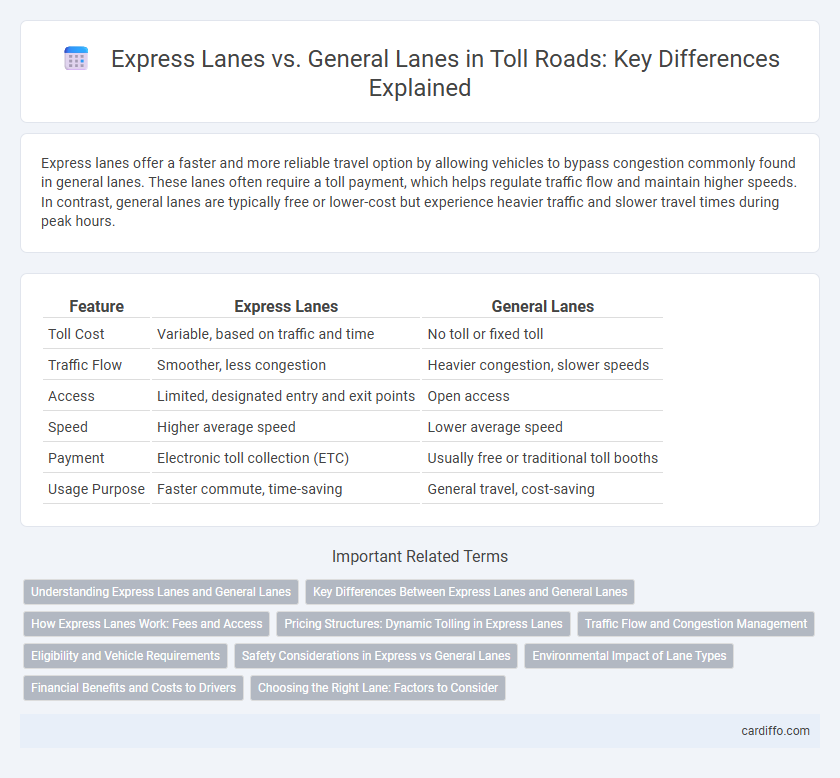Express lanes offer a faster and more reliable travel option by allowing vehicles to bypass congestion commonly found in general lanes. These lanes often require a toll payment, which helps regulate traffic flow and maintain higher speeds. In contrast, general lanes are typically free or lower-cost but experience heavier traffic and slower travel times during peak hours.
Table of Comparison
| Feature | Express Lanes | General Lanes |
|---|---|---|
| Toll Cost | Variable, based on traffic and time | No toll or fixed toll |
| Traffic Flow | Smoother, less congestion | Heavier congestion, slower speeds |
| Access | Limited, designated entry and exit points | Open access |
| Speed | Higher average speed | Lower average speed |
| Payment | Electronic toll collection (ETC) | Usually free or traditional toll booths |
| Usage Purpose | Faster commute, time-saving | General travel, cost-saving |
Understanding Express Lanes and General Lanes
Express lanes offer a faster travel option by utilizing dynamic toll pricing to manage traffic flow and reduce congestion, while general lanes operate without tolls but often experience heavier traffic and slower speeds. Express lanes use electronic toll collection systems, allowing vehicles to maintain consistent speeds, whereas general lanes accommodate all drivers without charging fees, which can lead to increased delays during peak hours. Understanding these differences helps drivers make informed decisions based on time, cost, and convenience preferences when navigating toll roads.
Key Differences Between Express Lanes and General Lanes
Express lanes offer dynamic pricing based on real-time traffic conditions, enabling faster travel by reducing congestion; general lanes maintain fixed toll rates and often face heavier traffic delays. Express lanes typically require electronic toll collection and may restrict access to high-occupancy vehicles or those meeting specific criteria, while general lanes are open to all vehicles without occupancy limitations. The primary distinction lies in congestion management and toll pricing strategies, where express lanes prioritize efficiency and travel time savings.
How Express Lanes Work: Fees and Access
Express lanes operate by charging dynamic toll fees based on real-time traffic conditions to manage congestion and maintain smoother traffic flow. Access typically requires a transponder or electronic toll tag, allowing vehicles to enter and exit lanes seamlessly without stopping, and fees vary depending on distance traveled and demand. These lanes prioritize high-occupancy vehicles and those willing to pay for reduced travel time, optimizing roadway efficiency and minimizing delays.
Pricing Structures: Dynamic Tolling in Express Lanes
Dynamic tolling in express lanes adjusts prices in real-time based on traffic conditions, ensuring optimal lane usage and reducing congestion. Unlike fixed pricing in general lanes, dynamic tolls vary by time of day, demand, and traffic flow, incentivizing drivers to choose faster routes during peak hours. This pricing strategy maximizes traffic efficiency and generates revenue for transportation infrastructure improvements.
Traffic Flow and Congestion Management
Express Lanes utilize dynamic toll pricing to regulate traffic flow, reducing congestion by encouraging drivers to choose faster, less crowded routes. General Lanes often experience slower traffic speeds and higher congestion due to unrestricted access and lack of demand-based pricing. Effective congestion management in Express Lanes results in more consistent travel times and improved overall highway efficiency.
Eligibility and Vehicle Requirements
Express Lanes typically require vehicles to meet specific eligibility criteria such as having a valid transponder or participating in carpool programs to access discounted toll rates. General Lanes allow all vehicles regardless of type or permit but usually charge standard toll rates without eligibility restrictions. Vehicle requirements for Express Lanes often exclude oversized or commercial vehicles, while General Lanes impose fewer restrictions to accommodate all traffic types.
Safety Considerations in Express vs General Lanes
Express lanes feature enhanced safety measures such as reduced congestion and consistent traffic flow, which lower the risk of rear-end collisions compared to general lanes. General lanes often experience variable speeds and frequent lane changes, increasing the likelihood of accidents and traffic disruptions. Toll systems in express lanes also support rapid incident response, improving overall road safety for commuters.
Environmental Impact of Lane Types
Express lanes reduce traffic congestion by promoting carpooling and smoother traffic flow, resulting in lower vehicle emissions compared to general lanes. General lanes often experience stop-and-go traffic, increasing fuel consumption and greenhouse gas emissions. Implementing express lanes supports environmental sustainability by decreasing air pollution and improving overall air quality.
Financial Benefits and Costs to Drivers
Express Lanes typically offer faster travel with variable toll pricing that adjusts based on traffic conditions, providing drivers with time savings but at an additional cost. General Lanes have no toll fees but often experience higher congestion, leading to longer travel times and potentially increased fuel consumption. Drivers must weigh the financial benefits of reduced travel time and fuel costs in Express Lanes against the toll expenses compared to the free but slower General Lanes.
Choosing the Right Lane: Factors to Consider
Choosing the right lane between express lanes and general lanes depends on factors like traffic volume, travel time urgency, and toll costs. Express lanes often offer faster, less congested routes but require paying higher tolls, while general lanes provide a free or lower-cost alternative with potential delays. Evaluating your schedule flexibility, budget, and real-time traffic updates helps determine the optimal lane for an efficient commute.
Express Lanes vs General Lanes Infographic

 cardiffo.com
cardiffo.com